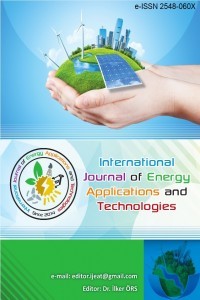Experimental flow analysis of vertical axis turbine for power generation in open channel system
Experimental flow analysis of vertical axis turbine for power generation in open channel system
Darrieus Water Turbine Energy, Hydraulic Energy, Renewable Energy, PIV,
___
- Şekeroğlu, E. 2019. “Investigation of flow and power parameters of a vertical Axis water turbine for stream application”. Master thesis, Osmaniye Korkut Ata University, Energy System Engineering Department, Osmaniye, Turkey, 1-85.
- Yaniktepe, B., Kara, O. and Ozalp, C., 2017. Technoeconomic evaluation for an ınstalled small-scale photovoltaic power plant. International Journal of Photoenergy, 1–7.
- Yaniktepe, B., Koroglu, T. and Savrun, M. M. 2013. Investigation of wind characteristics and wind energy potential in Osmaniye, Turkey. Renewable and Sustainable Energy Reviews, 21, 703–711.
- Demircan, E. 2014. “Vertical axis water turbine design and analysis for river applications using computational fluid dynamics”. Master Thesis, METU Mechanical Engineering Department, Ankara, Turkey, 57.
- Hwang, I. S., Lee, Y. H., Kim, S. J., Optimization of cycloidal water turbine and the performance improvement by individual blade control. Applied Energy, 86(9), 1532–1540, 2009.
- Alidadi, M. 2009. “Duct optimization for a ducted vertical axis hydro current türbine”. Ph.D. Thesis, The University of British Columbia, Vancouver, 1-122.
- Antheaume, S., Maître, T. and Achard, J. L. 2008. Hydraulic Darrieus turbines efficiency for free fluid flow conditions versus power farms conditions. Renewable Energy, 33(10), 2186–98.
- Li, Y. and Calisal, S. M. 2010. Three dimensional effects and arm effects on modeling a vertical axis tidal current türbine. Renewable Energy, 35(10), 2325–2334.
- Bachant, P. and Wosnik, M. 2016. Effects of reynolds number on the energy conversion and near wake dynamics of a high solidity vertical axis cross flow türbine. Energies, 9(2), 1–18.
- Khan, M. J., Bhuyan, G., Iqbal, M. T. and Quaicoe, J. E. 2009. Hydrokinetic energy conversion systems and assessment of horizontal and vertical axis turbines for river and tidal applications. A technology status review, Applied Energy, 86(10), 1823–1835.
- Hall, T.J. 2012. “Numerical simulation of a cross flow Marine Hydrokinetic turbine”, Master Thesis, Mechanical Engineering University of Washington, Washington, 1-95.
- Yayın Aralığı: Yılda 2 Sayı
- Başlangıç: 2014
- Yayıncı: İlker ÖRS
Anaerobic co-digestion of food waste, goat and chicken manure for sustainable biogas production
Detecting chemicals with high yield in pyrolytic liquid of spirulina sp. microalgae via GC-MS
Comparative exergy analysis of the cascade cooling system for alternative refrigerant couples
Erkan DİKMEN, Arzu ŞENCAN ŞAHİN
Investigation of the effects of biofuels on vehicle performance and emissions
Muhammet YILDIZ, Abdullah ÖZÇELİK
Ragıp YILDIRIM, Abdullah YILDIZ
Experimental flow analysis of vertical axis turbine for power generation in open channel system
Bülent YANIKTEPE, Ertuğrul ŞEKEROĞLU, Mustafa SÖYLER, Coskun ÖZALP
Mohammed TAHA, Ali ATES, Aziz Hakan ALTUN, Eyüb CANLI
An overview on the use of nanotechnology in the renewable energy field
Fracture energy comparison of aluminum and boron composites for fuel cell end plates
